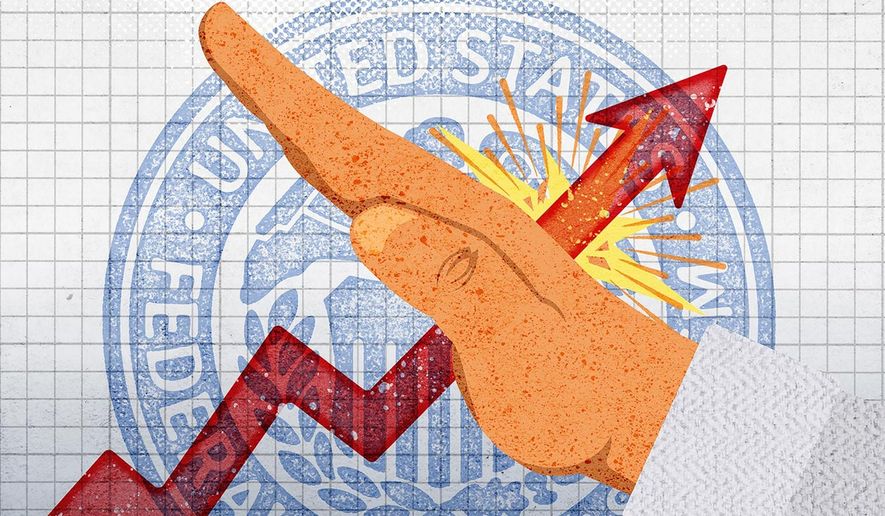OPINION:
The Federal Reserve should do more, say less and be more modest.
Although inflation, as measured on a year-over-year basis by the consumer price index, declined from its 9.1.% June peak to 7.7% in October, the Fed continues to confront tough structural challenges.
The Russian invasion of Ukraine is disrupting exports from the world’s second-largest producer of crude oil and creating pressures on global markets for grain and fertilizer. Elsewhere, climate change is wreaking havoc on farmers and river transportation networks. China’s imperial designs on the Pacific and industrial policies in high tech are inspiring a decoupling of U.S.-Chinese commerce.
Add in China’s strict approach to COVID-19, and about half of the recent surge in inflation has been attributed to supply-side issues.
Yet Chairman Jerome Powell recently asserted that “we have the tools that we need and the resolve it will take to restore price stability.” Americans should be curious to know how the Fed raising interest rates can bring peace to Ukraine, alter China’s ambitions and remove CO2 from the atmosphere.
Since Ben Bernanke was chairman, the Fed has made a concerted effort to be more transparent about its intentions. Policy surprises beget instability in financial markets and impede reasonable planning by businesses and households.
The fundamental problem is that the Fed can’t know where it is going next month or year without a clear picture of where inflationary pressures will persist or subside. And the institution is simply no better than private economists or armchair pundits at anticipating wars, weather patterns or the machinations of autocrats.
When inflation was less than the Fed’s 2% target, then-Chairman Janet Yellen told us deflationary pressures were temporary — they weren’t. As the economy recovered in 2021, Mr. Powell told us inflationary pressures were transitory. That turned out to be false.
The Fed is enamored by the notion — so popular among economists — that consumer and financial market expectations of future inflation are a good indicator of where inflation is headed. And let expectations get out of control and inflation will spiral like a cyclone.
The year-over-year rate of increase in the CPI went from 1.4% to 5% from January to May 2021. In May 2020, expected inflation one year hence as reported by the New York Federal Reserve household survey was 3% and the bond market as tracked by the St. Louis Federal pegged it at minus 0.2%.
As noted, inflation peaked at 9.1% in June. A year earlier, household and bond market conditions were forecasting 4.8% and 2.1%.
Dart boards are better, yet Fed policymakers talk about expectations every chance they get.
Jane Smith drives to work, shops for groceries and notes the prices of gasoline and milk. But she’s hardly in a position to weigh the likelihood and consequences of war and terrorism in Europe and the Middle East or when droughts will abate, if ever.
She’s likely more influenced by what NPR reports that Fed officials say is going to happen, and Jane and Jerome have become trapped in a hall of mirrors.
In the statement released after the Nov. 2 policymaking meeting, the Fed said future interest rate increases “will take into account the cumulative tightening of monetary policy, the lags with which monetary policy affects economic activity and inflation, and economic and financial developments.”
Taking that as a sign that the Fed will soon ease back from its pace of tightening, stock prices jumped. A few hours later, Mr. Powell disabused such thinking and stock prices plummeted.
I can’t think of what possessed him to put that language in the statement if he was going to walk it back. A culture has developed where market hangs on every utterance of Fed officials, and often those are contradictory.
On Nov. 10, for example, Cleveland Fed President Loretta Mester said she sees risks in the Fed tightening too little. Meanwhile, Dallas Fed President Lorie Logan was telling reporters that “it may soon be appropriate to slow the pace of rate increases.”
No wonder Jane Smith is confused, but perhaps no more so than Mr. Powell.
Most recently, CPI inflation has trended down but much of that has been energy prices, which have been strongly influenced by President Biden running down the Strategic Petroleum Reserve. That must end soon if enough oil is to be kept in the event of a crisis in the Middle East.
Subtracting energy from the CPI, inflation has not abated. It was 6.6% in June and 7.0% in October, and labor markets remain tight.
With supply-side factors beyond monetary policy’s influence contributing so much uncertainty to the inflation outlook, Mr. Powell and his colleagues would do well to be more reticent, simply state they will keep pushing up rates at 0.75% at each policymaking meeting until inflation is at 4% for several months and keep rates elevated until inflation descends convincingly to 2%.
• Peter Morici is an economist and emeritus business professor at the University of Maryland, and a national columnist.




Please read our comment policy before commenting.